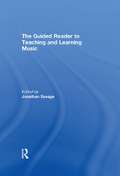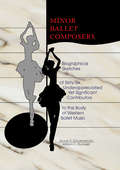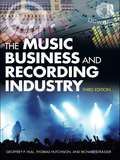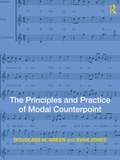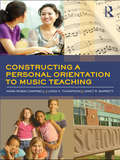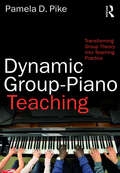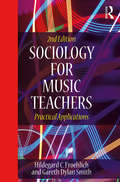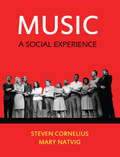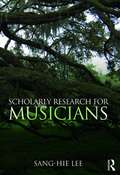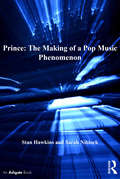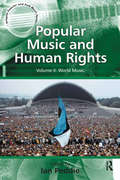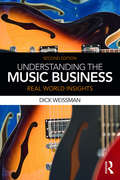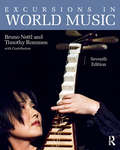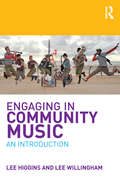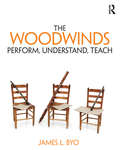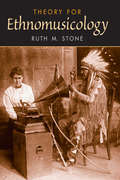- Table View
- List View
The Guided Reader to Teaching and Learning Music
by Jonathan SavageThe Guided Reader to Teaching and Learning Music draws on extracts from the published work of some of the most influential education writers to provide insight, guidance and clarity about key issues affecting Music teachers. The book brings together key extracts from classic and contemporary writing and contextualises these in both theoretical and practical terms. The extracts are accompanied by a summary of the key ideas and issues raised, questions to promote discussion and reflective practice, and annotated further reading lists to extend thinking. Taking a thematic approach and including a short introduction to each theme, the chapters cover: ? Analysing your own work as a music teacher; Concepts of musicality; Notions of musical development and progression; Pedagogies for teaching music musically; Music inside and outside the school; Formal, informal and non-formal approaches to music education; Productive methods of assessment and transition for music education; Creativity and music education; Supporting the gifted and talented in music; Using ICT within music education. ? Aimed at trainee and newly qualified teachers including those working towards Masters-level qualifications, as well practicing teachers, this accessible, but critically provocative text will be an essential resource for all teachers that wish to deepen their understanding of Music Education.
The Guided Reader to Teaching and Learning Music
by Jonathan SavageThe Guided Reader to Teaching and Learning Music draws on extracts from the published work of some of the most influential education writers to provide insight, guidance and clarity about key issues affecting Music teachers. The book brings together key extracts from classic and contemporary writing and contextualises these in both theoretical and practical terms. The extracts are accompanied by a summary of the key ideas and issues raised, questions to promote discussion and reflective practice, and annotated further reading lists to extend thinking. Taking a thematic approach and including a short introduction to each theme, the chapters cover: ? Analysing your own work as a music teacher; Concepts of musicality; Notions of musical development and progression; Pedagogies for teaching music musically; Music inside and outside the school; Formal, informal and non-formal approaches to music education; Productive methods of assessment and transition for music education; Creativity and music education; Supporting the gifted and talented in music; Using ICT within music education. ? Aimed at trainee and newly qualified teachers including those working towards Masters-level qualifications, as well practicing teachers, this accessible, but critically provocative text will be an essential resource for all teachers that wish to deepen their understanding of Music Education.
Minor Ballet Composers: Biographical Sketches of Sixty-Six Underappreciated Yet Significant Contributors to the Body of West
by William E Studwell Bruce R SchuenemanWhile most music lovers are familiar with the famous scores of Tchaikovsky, Delibes, and Stravinsky, many other lesser-known composers also wrote for the ballet. Several of these composers wrote almost exclusively for the ballet--and all enriched the world of dance. Minor Ballet Composers presents biographical sketches of 66 underappreciated ballet composers of the 19th and 20th centuries from around the world, along with selected stories from the ballets they helped create. While the composers’contributions to ballet music are emphasized, all aspects of their lives and works are touched upon. Plot summaries and excerpts from reviews of many of the ballets are also provided. Other topics of interest you’ll find covered in Minor Ballet Composers include: Les Six: Darius Milhaud, Louis Durey, Georges Auric, Arthur Honegger, Francis Poulenc, and Germaine Tailleferre--and their relationship with Erik Satie and Jean Cocteau how politics, revolutions, and wars have affected composers and their works who studied with whom; who collaborated with whom schools, movements, and musical renaissance the importance of opera to ballet music the relationship between film scores and ballet music which books, plays, stories, and folk tales certain ballets are based upon where many of these ballets premieredMinor Ballet Composers emphasizes the importance of second-tier composers and their influence on the rich tradition of music written for the dance (though in some cases the music was appropriated for the ballet from other original designs). The gathering of these composers in a single volume in appreciation of their ballet music, with a glossary of choreographers and an index of ballet titles, makes this book a useful volume for ballet aficionados, music librarians, musicians, and others interested in dance and dance music.
Minor Ballet Composers: Biographical Sketches of Sixty-Six Underappreciated Yet Significant Contributors to the Body of West
by William E Studwell Bruce R SchuenemanWhile most music lovers are familiar with the famous scores of Tchaikovsky, Delibes, and Stravinsky, many other lesser-known composers also wrote for the ballet. Several of these composers wrote almost exclusively for the ballet--and all enriched the world of dance. Minor Ballet Composers presents biographical sketches of 66 underappreciated ballet composers of the 19th and 20th centuries from around the world, along with selected stories from the ballets they helped create. While the composers’contributions to ballet music are emphasized, all aspects of their lives and works are touched upon. Plot summaries and excerpts from reviews of many of the ballets are also provided. Other topics of interest you’ll find covered in Minor Ballet Composers include: Les Six: Darius Milhaud, Louis Durey, Georges Auric, Arthur Honegger, Francis Poulenc, and Germaine Tailleferre--and their relationship with Erik Satie and Jean Cocteau how politics, revolutions, and wars have affected composers and their works who studied with whom; who collaborated with whom schools, movements, and musical renaissance the importance of opera to ballet music the relationship between film scores and ballet music which books, plays, stories, and folk tales certain ballets are based upon where many of these ballets premieredMinor Ballet Composers emphasizes the importance of second-tier composers and their influence on the rich tradition of music written for the dance (though in some cases the music was appropriated for the ballet from other original designs). The gathering of these composers in a single volume in appreciation of their ballet music, with a glossary of choreographers and an index of ballet titles, makes this book a useful volume for ballet aficionados, music librarians, musicians, and others interested in dance and dance music.
The Music Business and Recording Industry
by Geoffrey P Hull Thomas Hutchison Richard StrasserThe Music Business and Recording Industry is a comprehensive music business textbook focused on the three income streams in the music industry: music publishing, live entertainment, and recordings. The book provides a sound foundation for understanding key issues, while presenting the latest research in the field. It covers the changes in the industry brought about by the digital age, such as changing methods of distributing and accessing music and new approaches in marketing with the Internet and mobile applications. New developments in copyright law are also examined, along with the global and regional differences in the music business.
The Music Business and Recording Industry
by Geoffrey P Hull Thomas Hutchison Richard StrasserThe Music Business and Recording Industry is a comprehensive music business textbook focused on the three income streams in the music industry: music publishing, live entertainment, and recordings. The book provides a sound foundation for understanding key issues, while presenting the latest research in the field. It covers the changes in the industry brought about by the digital age, such as changing methods of distributing and accessing music and new approaches in marketing with the Internet and mobile applications. New developments in copyright law are also examined, along with the global and regional differences in the music business.
The Principles and Practice of Modal Counterpoint
by Douglass Green Evan JonesCovering modal music from Gregorian chant through the seventeenth-century, The Principles and Practice of Modal Counterpoint is a comprehensive textbook combining stylistic composition, theory and analysis, music history, and performance. By supplementing a modified species approach with a wealth of complete musical examples and historical information, this textbook thoroughly joins principle with practice, providing a truly immersive experience in the study of modal counterpoint and familiarizing students with modal repertoire.
The Principles and Practice of Modal Counterpoint
by Douglass Green Evan JonesCovering modal music from Gregorian chant through the seventeenth-century, The Principles and Practice of Modal Counterpoint is a comprehensive textbook combining stylistic composition, theory and analysis, music history, and performance. By supplementing a modified species approach with a wealth of complete musical examples and historical information, this textbook thoroughly joins principle with practice, providing a truly immersive experience in the study of modal counterpoint and familiarizing students with modal repertoire.
Constructing a Personal Orientation to Music Teaching
by Mark Robin Campbell Linda K Thompson Janet R. BarrettConstructing a Personal Orientation to Music Teaching promotes inquiry and reflection to facilitate teacher growth, lifelong learning and a disposition toward educational change. Strongly grounded in current theories and research in teacher education, the text engages readers in analyzing their own experiences in order to conceptualize the complexity of teaching; involves them in clarifying their reasons for seeking a career in teaching; supports their insights, questions, and reflections about their work; and promotes a reflective, critical attitude about schools in general as teachers are urged to think of themselves as change agents in school settings.
Constructing a Personal Orientation to Music Teaching
by Mark Robin Campbell Linda K Thompson Janet R. BarrettConstructing a Personal Orientation to Music Teaching promotes inquiry and reflection to facilitate teacher growth, lifelong learning and a disposition toward educational change. Strongly grounded in current theories and research in teacher education, the text engages readers in analyzing their own experiences in order to conceptualize the complexity of teaching; involves them in clarifying their reasons for seeking a career in teaching; supports their insights, questions, and reflections about their work; and promotes a reflective, critical attitude about schools in general as teachers are urged to think of themselves as change agents in school settings.
Dynamic Group-Piano Teaching: Transforming Group Theory into Teaching Practice
by Pamela PikeDynamic Group-Piano Teaching provides future teachers of group piano with an extensive framework of concepts upon which effective and dynamic teaching strategies can be explored and developed. Within fifteen chapters, it encompasses learning theory, group process, and group dynamics within the context of group-piano instruction. This book encourages teachers to transfer learning and group dynamics theory into classroom practice. As a piano pedagogy textbook, supplement for pedagogy classes, or resource for graduate teaching assistants and professional piano teachers, the book examines learning theory, student needs, assessment, and specific issues for the group-piano instructor.
Sociology for Music Teachers: Practical Applications
by Gareth Dylan Smith Hildegard FroehlichSociology for Music Teachers: Practical Applications, Second Edition, outlines the basic concepts relevant to understanding music teaching and learning from a sociological perspective. It demonstrates the relationship of music to education, schooling and society, and examines the consequences for making instructional choices in teaching methods and repertoire selection. The authors look at major theories, and concepts relevant to music education, texts in the sociology of music, and thoughts of selected ethnomusicologists and sociologists. The new edition takes a more global approach than was the case in the first edition and includes the application of sociological theory to contexts beyond the classroom. The Second Edition: Presents major theories in ethnomusicology, both traditional and contemporary. Takes a global approach by presenting a variety of teaching practices beyond those found in the United States. Emphasizes music education in a traditional classroom setting, but also applies specific constructs to studio teaching situations in conservatories (with private lessons) and community music. Provides recommendations for teaching practices by addressing popular music in school music curricula, suggests inclusionary projects that explore musical styles and repertoire of the past and present, and connects school to community music practices of varying kinds. Contains an increased number of suggestions for projects and discussions among the students using the book.
Music: A Social Experience
by Steven Cornelius Mary NatvigMusic: A Social Experience offers a topical approach for a music appreciation course. Through a series of subjects–from Music and Worship to Music and War and Music and Gender–the authors present active listening experiences for students to experience music's social and cultural impact. The book offers an introduction to the standard concert repertoire, but also gives equal treatment to world music, rock and popular music, and jazz, to give students a thorough introduction to today's rich musical world. Through lively narratives and innovative activities, the student is given the tools to form a personal appreciation and understanding of the power of music. The book is paired with MySearchLab, featuring listening guides with streaming audio, short texts on special topics, and sample recordings and notation to illustrate basic concepts in music.
Music: A Social Experience
by Steven Cornelius Mary NatvigMusic: A Social Experience offers a topical approach for a music appreciation course. Through a series of subjects–from Music and Worship to Music and War and Music and Gender–the authors present active listening experiences for students to experience music's social and cultural impact. The book offers an introduction to the standard concert repertoire, but also gives equal treatment to world music, rock and popular music, and jazz, to give students a thorough introduction to today's rich musical world. Through lively narratives and innovative activities, the student is given the tools to form a personal appreciation and understanding of the power of music. The book is paired with MySearchLab, featuring listening guides with streaming audio, short texts on special topics, and sample recordings and notation to illustrate basic concepts in music.
Scholarly Research for Musicians
by Sang-Hie LeeScholarly Research for Musicians presents a range of research methods and techniques, incorporating both the common elements of traditional music research methodologies with innovative research strategies endemic to the fields of social science, education, and performance science. The author’s collaborative and interdisciplinary approach reinforces the belief that research is most palpable and successful when accessed through a relevant and meaningful way of organizing thoughts and knowledge. Drawing from over twenty years of classroom experience, the author organizes the text into five units: Common Bases, Qualitative Research, Quantitative Research, Performance Science, and Review. Research is presented as an accessible process, one facilitated by brainstorming and question-asking, the systematic collection of information, and the analysis and synthesis of information—all with the aim to develop a succinct conceptual framework. In explicating this process, the author introduces traditional Western thought alongside contemporary and Eastern philosophy. Experts in the field of performance science explore novel approaches to studying the audience, incorporating various measuring devices and methods. In the final chapter, the author offers strategies for disseminating and publishing research reports. Scholarly Research for Musicians demystifies the research process for musicians and music students alike, demonstrating the common principles of cohesive research plans. PowerPoint presentations are available to instructors, covering chapter discussion points in summary format. This text explores interdisciplinary methods that merge with and focus on the study of music while emphasizing concepts and materials relevant to all types of research.
Scholarly Research for Musicians
by Sang-Hie LeeScholarly Research for Musicians presents a range of research methods and techniques, incorporating both the common elements of traditional music research methodologies with innovative research strategies endemic to the fields of social science, education, and performance science. The author’s collaborative and interdisciplinary approach reinforces the belief that research is most palpable and successful when accessed through a relevant and meaningful way of organizing thoughts and knowledge. Drawing from over twenty years of classroom experience, the author organizes the text into five units: Common Bases, Qualitative Research, Quantitative Research, Performance Science, and Review. Research is presented as an accessible process, one facilitated by brainstorming and question-asking, the systematic collection of information, and the analysis and synthesis of information—all with the aim to develop a succinct conceptual framework. In explicating this process, the author introduces traditional Western thought alongside contemporary and Eastern philosophy. Experts in the field of performance science explore novel approaches to studying the audience, incorporating various measuring devices and methods. In the final chapter, the author offers strategies for disseminating and publishing research reports. Scholarly Research for Musicians demystifies the research process for musicians and music students alike, demonstrating the common principles of cohesive research plans. PowerPoint presentations are available to instructors, covering chapter discussion points in summary format. This text explores interdisciplinary methods that merge with and focus on the study of music while emphasizing concepts and materials relevant to all types of research.
Prince: The Making of a Pop Music Phenomenon (Ashgate Popular and Folk Music Series)
by Sarah Niblock Stan HawkinsThe career of the prolific pop artist Prince has become inextricably intertwined with the history of popular music since the late 1970s. This multi-instrumental icon, who remains one of the highest-grossing live performers in America, has been called a genius for his musicianship, composition and incredible performances. But Prince holds iconic status for more than his music. Best known for his racial blurring and extravagant sexual persona, Prince's music and visual iconography has always chimed with the ambiguity of subjectivity at any given moment. 'Prince' the sign offers a space for fans to evaluate and reconfigure their attitudes towards their own identities, and towards their position as subjects within the socio-cultural sphere. This much-needed interdisciplinary analysis is the first of its kind to examine critically Prince's popular music, performances, sounds, lyrics and the plethora of accompanying visual material such as album covers, posters, fashions, promotional videos and feature films. Specifically, the book explores how and why he has played such a profoundly meaningful and significant role in his fans' lives.
Popular Music and Human Rights: World Music
by Ian PeddiePopular music has long understood that human rights, if attainable at all, involve a struggle without end. The right to imagine an individual will, the right to some form of self-determination and the right to self-legislation have long been at the forefront of popular music's approach to human rights. At a time of such uncertainty and confusion, with human rights currently being violated all over the world, a new and sustained examination of cultural responses to such issues is warranted. In this respect music, which is always produced in a social context, is an extremely useful medium; in its immediacy music has a potency of expression whose reach is long and wide. Contributors to this significant volume cover artists and topics such as Billy Bragg, punk, Fun-da-Mental, Willie King and the Liberators, Hedwig and the Angry Inch, the Anti-Death Penalty movement, benefit concerts, benefit albums, Gil Scott-Heron, Bruce Springsteen, Wounded Knee and Native American political resistance, Tori Amos, Joni Mitchell, as well as human rights in relation to feminism. A second volume covers World Music.
Popular Music and Human Rights: World Music
by Ian PeddiePopular music has long understood that human rights, if attainable at all, involve a struggle without end. The right to imagine an individual will, the right to some form of self-determination and the right to self-legislation have long been at the forefront of popular music's approach to human rights. At a time of such uncertainty and confusion, with human rights currently being violated all over the world, a new and sustained examination of cultural responses to such issues is warranted. In this respect music, which is always produced in a social context, is an extremely useful medium; in its immediacy music has a potency of expression whose reach is long and wide. Contributors to this significant volume cover artists and topics such as Billy Bragg, punk, Fun-da-Mental, Willie King and the Liberators, Hedwig and the Angry Inch, the Anti-Death Penalty movement, benefit concerts, benefit albums, Gil Scott-Heron, Bruce Springsteen, Wounded Knee and Native American political resistance, Tori Amos, Joni Mitchell, as well as human rights in relation to feminism. A second volume covers World Music.
Understanding the Music Business: Real World Insights
by Dick WeissmanIn today’s fast-moving music industry, what does it take to build a life-long career? Now more than ever, all those working in music need to be aware of many aspects of the business, and take control of their own careers. Understanding the Music Business offers students a concise yet comprehensive overview of the rapidly evolving music industry, rooted in real-world experiences. Anchored by a wealth of career profiles and case studies, this second edition has been updated throughout to include the most important contemporary developments, including the advent of streaming and the shift to a DIY paradigm. A new "Both Sides Now" feature helps readers understand differing opinions on key issues. Highly readable, Understanding the Music Business is the perfect introduction for anyone seeking to understand how musical talents connect to making a living.
Excursions in World Music, Seventh Edition: eBook & mp3 Value Pack
by Bruno Nettl Timothy RommenExcursions in World Music is a comprehensive introductory textbook to world music, creating a panoramic experience for students by engaging the many cultures around the globe and highlighting the sheer diversity to be experienced in the world of music. At the same time, the text illustrates the often profound ways through which a deeper exploration of these many different communities can reveal overlaps, shared horizons, and common concerns in spite of and, because of, this very diversity. The new seventh edition introduces five brand new chapters, including chapters by three new contributors on the Middle East, South Asia, and Korea, as well as a new chapter on Latin America along with a new introduction written by Timothy Rommen. General updates have been made to other chapters, replacing visuals and updating charts/statistics. Excursions in World Music remains a favorite among ethnomusicologists who want students to explore the in-depth knowledge and scholarship that animates regional studies of world music. A companion website is available at no additional charge. For instructors, there is a new test bank and instructor's manual. Numerous student resources are posted, including streamed audio tracks for most of the listening guides, interactive quizzes, ?ashcards, and an interactive map with pinpoints of interest and activities. An ancillary package of a 3-CD set of audio tracks is available for separate purchase. PURCHASING OPTIONS Paperback: 9781138101463 Hardback: 9781138688568 eBook and mp3 file: 9781315619378* Print Paperback Pack - Book and CD set: 9781138666443 Print Hardback Pack - Book and CD set: 9781138666436 Audio CD: 9781138688032 *See VitalSource.com for various eBook options (mp3 audio compilation not available for separate sale)
Engaging in Community Music: An Introduction
by Lee Higgins Lee WillinghamEngaging in Community Music: An Introduction focuses on the processes involved in designing, initiating, executing and evaluating community music practices. Designed for both undergraduate and graduate students, in community music programmes and related fields of study alike, this co-authored textbook provides explanations, case examples and ‘how-to’ activities supported by a rich research base. The authors have also interviewed key practitioners in this distinctive field, encouraging interviewees to reflect on aspects of their work in order to illuminate best practices within their specialisations and thereby establishing a comprehensive narrative of case study illustrations. Features: a thorough exploration and description of the emerging field of community music; succinctly and accessibly written, in a way in which students can relate; interviews with 26 practitioners in the US, UK, Australia, Europe, Canada, Scandinavia and South Africa, where non-formal education settings with a music leader, or facilitator, have experienced success; case studies from many cultural groups of all ages and abilities; research on life-long learning, music in prisons, music and ritual, community music therapy, popular musics, leisure and recreation, business and marketing strategies, online communities – all components of community music.
The Woodwinds: Perform, Understand, Teach
by James ByoThe Woodwinds: Perform, Understand, Teach provides comprehensive coverage about the woodwind family of musical instruments for prospective instrumental music teachers. What sets this book apart is its focus on how to teach the instruments. Preparing students in the how of teaching is the ultimate goal of the woodwind class and the ultimate goal of this book, which organizes information by its use in teaching beginning instrumentalists. In developing performance and understanding, pre-service teachers are positioned to learn to teach through performance—contrasted with an "old-school" belief that one must first spend much time tediously trying to understand how things work before playing the instruments. The book is organized in three parts: Preliminaries, Teaching the Instruments, and Foundations. Chapters in Teaching the Instruments are organized by instrument (flute, clarinet, saxophone, oboe, bassoon) and, within each instrument, according to how an effective teacher might organize experiences for novice learners. Basic embouchure and air stream are covered first, followed by instrument assembly, then hands and holding. Embouchure coverage returns in greater depth, then articulation, and finally "the mechanism," which includes sections on the instruments of the family, transposition, range, special fingerings, tuning and intonation, and reeds. In Foundations, topics are situated in big picture contexts, calling attention to the broad applicability of information across instruments.
Theory for Ethnomusicology
by Ruth M. StoneFor courses in ethnomusicological theory. This book covers ethnomusicological theory, exploring some of the underpinnings of different approaches and analyzing differences and commonalities in these orientations. This text addresses how ethnomusicologists have used and applied these theories in ethnographic research.
Theory for Ethnomusicology
by Ruth M. StoneFor courses in ethnomusicological theory. This book covers ethnomusicological theory, exploring some of the underpinnings of different approaches and analyzing differences and commonalities in these orientations. This text addresses how ethnomusicologists have used and applied these theories in ethnographic research.
